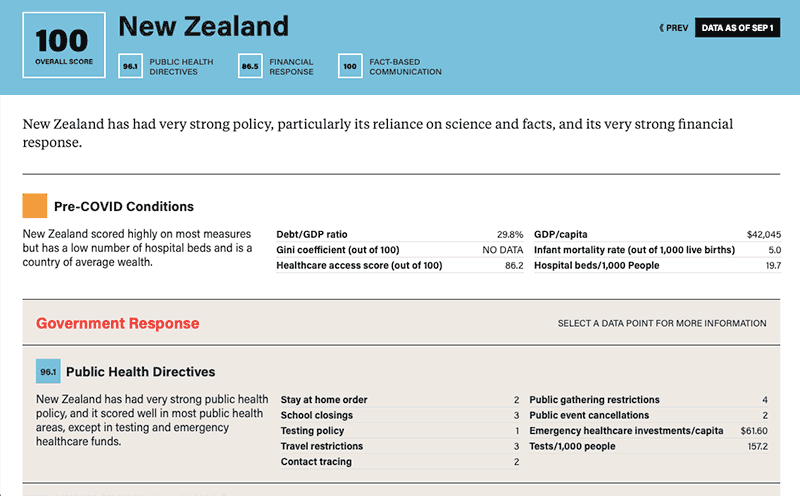Travel and tourism will be changed forever. We asked seven leading thinkers for their predictions.
Belgium
- Data as of Aug 1
- Next 》
- 4.2 Public Health
Directives - 33.5 Financial
Response - 100 Fact-Based
Communication
- 4.2 Public Health
Directives - 33.5 Financial
Response - 100 Fact-Based
Communication
Belgium has a relative strong score, with its generous income support and strong testing and contact tracing countered by limited public health directives.
Pre-COVID Conditions
Belgium had relatively strong pre-pandemic capacity, boasting accessible, quality healthcare, a healthy population, relatively low levels of inequality, and one of the highest rates of hospital beds per 100,000 people in the Index.
- Debt/GDP ratio 102%
- GDP/capita $50,905
- Gini coefficient (out of 100) 27.4
- Infant mortality rate (out of 1,000 live births) 3
- Healthcare access score (out of 100) 87.9
- Hospital beds/1,000 People 44.5
Government Response
Select a data point for more information(Data points represent policy level as of Aug 1.)
Public Health Directives
Despite providing accessible testing and strong contact tracing, Belgium’s relatively weak policy on lockdowns, school closings, and low emergency healthcare spending has caused a high case and death rate, resulting in a very weak score.
- Stay at home order 0
- Public gathering restrictions 4
- School closings 0
- Public event cancellations 2
- Testing policy 2
- Emergency healthcare investments/capita $144.09
- Travel restrictions 3
- Tests/1,000 people 1.7
- Contact tracing 1
Financial Response
Belgium has deployed generous income support for workers, but its high case rate undercuts the impact of its financial response.
- Financial stimulus as share of GDP 19.7%
- Income support 2
- Debt forebearance 1
Fact-Based Communication
Belgium’s government has communicated regularly with the public, avoiding misinformation or exaggeration, and publishing excess death numbers as well as more basic statistics.
- Reliance on science/fact based information 0
- Press freedom 0
COVID-19 Status as of Aug 1
Belgium has the highest death rate in the Index, which health authorities attribute to COVID’s spread in care homes and a high case rate, though they seem to be capturing most cases through testing.
- Total deaths 9,709
- Death rate per 100K 837.7
- Total cases 70,281
- Cases per 100K 6,064
- Percent of positive tests 2.6
| Date | Status | New Cases/1M | |
|---|---|---|---|
| 1 | May 04 | Some businesses reopen | 38.15 |
| 2 | May 18 | Shops and schools reopen | 25.53 |
| 3 | Jun 08 | Religious institutions reopen | 10.44 |
| 4 | Jul 01 | Malls and pools reopen | 7.16 |
Differentiating Factors
- Hotspots in nursing homes: More than half of Belgium's coronavirus fatalities have occurred in nursing homes, partly because elderly people in Belgium are more likely than their peers in the rest of Europe to live in elder-care housing. Read More
- Stockpiling for second wave: In early July, Belgium's Minister of Health announced that the country had prepared itself for a second wave, having stockpiled PPE, medicine, tests and equipment such as ventilators. Read More
- Businesses hard hit despite support: Despite generous financial stimuli in response to the pandemic, financial analysts are predicting that as many as 50,000 Belgian businesses may file for bankruptcy in the coming months. Read More
Compared with Neighboring Countries
-
67.2Germany 209,653
Cases 2,502
Per 1M 9,141
DeathsGermany has improved its score a bit in the past few months, after a sharp decline in the fall. Its improvements in contact tracing, which are already likely underestimated in the data, and restrictions on public gatherings, have played important roles in this turnaround, although there has been a recent spike in cases, likely due to both recent restriction relaxations and vaccine rollout issues.
-
71.9Norway 9,208
Cases 1,699
Per 1M 255
DeathsNorway scores just below the median, pulled down by its weak public health and financial response scores, despite a strong reliance on facts and a free press.
-
51.6Sweden 76,937
Cases 7,618
Per 1M 5,762
DeathsDespite being known for a relatively strong public healthcare system, Sweden has been hit hard with cases; the country’s lack of stay-at-home orders and school closures, limited testing, and few gathering restrictions overshadowed its financial support, reliance on facts, and accountability with an open press.
Further Reading From Foreign Policy
Be the source of actionable insight.
Select one of the subscription options below to read the full Covid-19 Global Response Index. Unlock even more global intelligence with a subscription to FP Insider.
Already an FP Insider? Log In
Looking for group access? Contact us directly

Statistics and government response factors available on each country profile include:
Pre-COVID Conditions:
- Debt to GDP ratio
- Infant mortality rates
- Hospital beds per 1,000 people
- Gini coefficients measuring inequality
- Health access and quality
COVID-19 Public Health Directives:
- Stay-at home orders
- School-closing policy
- Public-gathering restrictions
- Cancellation of public events
- Testing policy and rates per 1,000 people
- Emergency healthcare spending per capita
- Travel restrictions
- Contact tracing
COVID-19 Financial Response:
- Stimulus package as a share of GDP
- Income support
- Debt-forbearance
Public Communications:
- Instances of misinformation by leadership
- Limitations on press freedom, censorship
Current/Historic In-Country COVID-19 Status:
- Death rates per 1 million
- Case rates per 1 million


